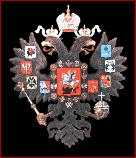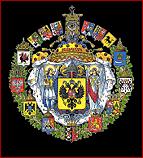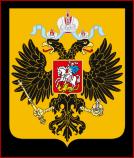
The Lesser State Emblem
of the Russian Empire
|

The Great State Emblem
of the Russian Empire
|

The State Emblem
of the Russian Empire
|
A Brief Overview of Russian Hallmarking
Russian standardized hallmarking, as we know it today, stems from a 1700 ukaz or decree of Tsar Peter the Great (1672-1725). While in the process of reforming the Russian monetary system, Tsar Peter I's silver assay charter fixed the production of silversmiths to four standard silver purities: 96, 90, 84 and 62 zolotniki. A zolotnik is an obsolete Russian weight measure and within this system there are 96 zolotniki to a troy pound, thus:
|
 |
96 zolotniki = 96/96 or 1000/1000 parts pure silver or .1000
90 zolotniki = 90/96 or 937/1000 parts pure silver or .937
84 zolotniki = 84/96 or 875/1000 parts pure silver or .875
62 zolotniki = 62/96 or 645/1000 parts pure silver or .645
|
note: As from 1732, the standard of 72 zolotniki (.750) was added and in 1779, it fully replaced 62 zolotniki as the legal minimum standard.
As from 1798, the 84 zolotniki (.875) standard replaced 72 zolotniki as the legal minimum standard. Athough 88 & 91 zolotniki were sometimes used on higher quality work, 84 zolotniki is the most commonly seen silver standard used in Russia throughout the 19th and early 20th centuries.
The Assay Charter of February 13th 1700 also stipulated that all gold and silver marks must be registered and objects made of these precious metals must carry; a master's or maker's mark, an assayer's mark, a fineness or standard mark, and a town mark. In addition, both the assayers and masters were obliged by law to register in the town or district they worked and it was forbidden to register in more than one place at the same time. Therefore it is important to note that when identifying a series of marks; the maker's mark, assayer's mark,and town mark must correspond. Also the working period of the master, assayer and their location must as well correspond. If not, the marks must be considered suspect. Below are examples of the four standard touchmarks:
|
 |
Maker's Mark - initials of the master silversmith responsible for the piece, these can be in either Cyrillic or Latin letters, sometimes a full name is stamped.
|
 |
Assayer's Mark - initials of the assay master with year date below. It was strictly forbidden for the assayer to punch his mark on any object unless it had previously been punched with a maker's mark.
|
 |
Silver Standard Mark - two numerals in a rectangle indicating the silver fineness or purity in zolotniki; 62, 72, 74, 76, 82, 84, 87, 88, 89, 90, 91, and 94 have all been used at one time or another, only 84 and above from 1798.
|
 |
Town Mark - usually a device from the Arms of the city/town indicated. Beginning in the mid 19th century, the town mark and standard mark were punched close beside each other often looking to be a single mark.
|
The Kokoshnik Marks
In 1896, Tsar Nicholas II (1868-1918) issued an edict that reformed this old system and the Kokoshnik mark came into being as the new assayer's mark. As thousands of new diestamps had to be created, the kokoshnik did not come into full use until early 1899.
|
 |
Until 1908, the mark consisted of a left facing woman's head in profile within an oval cartouche, she is wearing the peasant headdress traditionally referred to as a kokoshnik. To her left is the standard number and to her right are the assayer's initials which also indicate the assay office. The delineation within the oval is rendered in intaglio.
|
 |
From 1908, her profile is facing right with standard number to her right, to her left is a small Greek letter that indicates the city or region of assay. The delineation within the oval is rendered in relief.
|
Import Marks
Precious metal goods imported into Russia prior to 1882 were not marked as imports. At first, they were left completely unmarked, later they were submitted for assay and carry an assayer's mark only. Customs brought the imported objects to the assaying office for testing, if the fineness was 84 zolotniki or more the assayer punched his mark, if the fineness was less the import was denied.
|
 |
In 1882 a new special hallmark was introduced for imports only. It was a compound mark with the fineness, the town mark and the Cyrillic letters ПТ (Latin PT) meaning ПРИВОЗНЫХ ТОВАРОВ (Imported Goods). The use of this mark was discontinued in late 1898.
|
 |
As from 1899, in connection with the new assay marks that were instituted, a new import mark was also introduced. It was the kokoshnik mark in a standing oval with its lower end flattened. The kokoshnik looked left and behind its neck was a capital letter indicating the assayer's surname. In this case Cyrillic P is the assayer Aleksandr Romanov.
|
 |
As from the second kokshnik mark of 1908, the import mark's face is turned right and the Cyrillic letter superseded with a Greek letter indicating the assay office, in this case the delta for Moscow.
|
• • •
Russian Silver Marks Menu
|
|
|
|


















